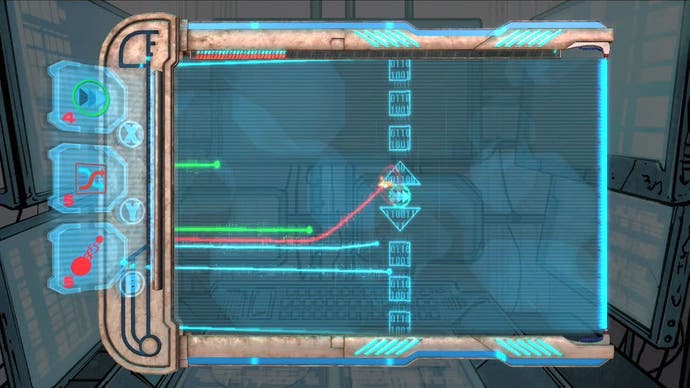Dead Space Ignition
Necro filler.
As this maturing medium grapples with the intricacies of interactive storytelling, it's little wonder we're seeing digital worlds expand beyond traditional boundaries and into other media. From novels to comics to viral web campaigns, publishers are understandably keen to explore other ways of keeping a brand name in the popular consciousness. An interactive comic with hacking mini-games is a new one, though.
Ignition is an "interquel", ostensibly dealing with the arrival of the Necromorphs on The Sprawl, the huge space station on which Dead Space 2 is set. For much of its brief duration – you're looking at 90 minutes to two hours for a first play through, though there are branching paths and four different endings – you'll watch a series of comic-book scenes featuring expert hacker Franco DeLille and his feisty companion Sarah Anderson.
The former's a bit of a personality black hole, reacting to impending peril with all the concern of a man who can't remember whether or not he left the landing light on, while the latter aims for 'lascivious' but hits 'irritating'. Her first line is a "that's what she said" gag, and neither the dialogue nor the performances really get any better from there.
Periodically, the pair will come across a door that needs hacking or an airlock that needs hacking or a space suit that needs hacking, or any number of tenuous reasons to pull out DeLille's all-purpose hacking machine. There's so much hacking going on that you half expect Jonny Lee Miller and Angelina Jolie to turn up. Though they made it look a lot more fun than it is here.

There are three different kinds of hack. First up is Trace Route, or Art Style Light Trax, as it's otherwise known. It's a pretty shameless rip-off of the WiiWare title – itself owing a not-insubstantial debt to Tron's light cycles – but with little of that game's style. The idea is to guide a red line through a scrolling course, avoiding abstract obstacles and beating the system's countermeasures to the finish.
It's curiously sluggish, visually flat, and manages the rare feat of being simultaneously easy yet frustrating. You'll invariably win the race, despite having spent an inordinate amount of time slowing down or crashing thanks to the display showing far too little of the road ahead. The courses theoretically get more difficult, but as you progress you're offered more power-ups to take down your rivals – one reverses their controls, another puts up a small wall to slow them down – so it never actually feels any tougher, even though you're dodging and weaving more than you did in the earlier stages.
System Override is an initially unfathomable task, thanks mainly to poor instructions but also a visual set-up that's hardly forthcoming with the feedback. It soon transpires that it's a kind of tower defence game in reverse, which isn't nearly as much fun as that sounds. It takes place on a hexagonal board which looks like the most complicated version of Blockbusters ever, as you fire viruses from one side of the map to overload the system core while anti-virus measures attempt to shoot them down.


